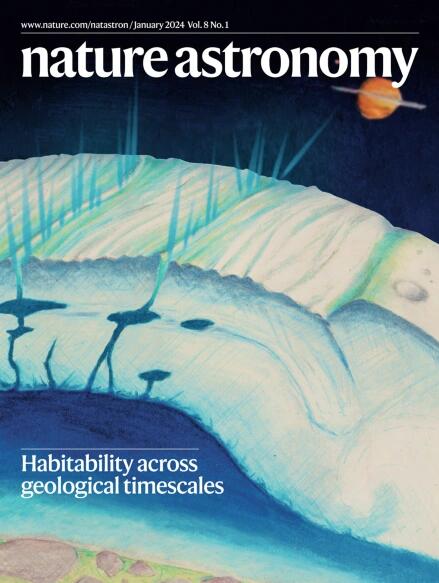Co-precession of a curved jet and compact accretion disk in M87
IF 14.3
1区 物理与天体物理
Q1 ASTRONOMY & ASTROPHYSICS
引用次数: 0
Abstract
Observational constraints on the configuration of the black hole (BH)–accretion disk–jet system are crucial to understanding BH spin, accretion disk physics and jet formation. The recently reported variation in the position angle of the M87 jet provides a new avenue for exploring these long-standing issues. The observed ~11-year periodicity, spanning over two cycles, is consistent with the Lense–Thirring precession of a compact, tilted accretion disk. However, how such a compact region decouples from the larger-scale accretion flow remains an open question in current numerical simulations. The jet precession challenges the traditional view of a strictly collimated jet by revealing a subtle curvature in the inner regions of the jet that dynamically links the jet to the spinning BH and successfully accounts for its unexpectedly wide inner projected profile. Although continued long-term observations are needed to distinguish coherent precession from stochastic fluctuations in the disk or jet orientation, these results open a new window for probing BH systems through coordinated multiscale observations and follow-on theoretical models. M87’s jet is precessing with a relatively short 11-year period and seems to be curved in the vicinity of the black hole, rather than being strictly collimated. This indicates the presence of a compact accretion disk and points to gaps in our understanding of jet dynamics.


M87中弯曲射流与致密吸积盘的共进动
黑洞-吸积盘-喷流系统构型的观测约束对于理解黑洞自旋、吸积盘物理和喷流形成至关重要。最近报道的M87飞机的位置角度变化为探索这些长期存在的问题提供了新的途径。观测到的约11年的周期,跨越两个周期,与致密倾斜吸积盘的透镜-蒂林进动相一致。然而,在目前的数值模拟中,这样一个紧凑的区域如何与更大规模的吸积流解耦仍然是一个悬而未决的问题。喷流进动揭示了喷流内部区域的微妙曲率,将喷流与旋转的黑洞动态地联系在一起,并成功地解释了其出乎意料的宽内部投影轮廓,从而挑战了严格准直喷流的传统观点。虽然需要持续的长期观测来区分盘或喷流方向的相干进动和随机波动,但这些结果为通过协调的多尺度观测和后续理论模型探索黑洞系统打开了一扇新的窗口。
本文章由计算机程序翻译,如有差异,请以英文原文为准。
求助全文
约1分钟内获得全文
求助全文
来源期刊

Nature Astronomy
Physics and Astronomy-Astronomy and Astrophysics
CiteScore
19.50
自引率
2.80%
发文量
252
期刊介绍:
Nature Astronomy, the oldest science, has played a significant role in the history of Nature. Throughout the years, pioneering discoveries such as the first quasar, exoplanet, and understanding of spiral nebulae have been reported in the journal. With the introduction of Nature Astronomy, the field now receives expanded coverage, welcoming research in astronomy, astrophysics, and planetary science. The primary objective is to encourage closer collaboration among researchers in these related areas.
Similar to other journals under the Nature brand, Nature Astronomy boasts a devoted team of professional editors, ensuring fairness and rigorous peer-review processes. The journal maintains high standards in copy-editing and production, ensuring timely publication and editorial independence.
In addition to original research, Nature Astronomy publishes a wide range of content, including Comments, Reviews, News and Views, Features, and Correspondence. This diverse collection covers various disciplines within astronomy and includes contributions from a diverse range of voices.
 求助内容:
求助内容: 应助结果提醒方式:
应助结果提醒方式:


